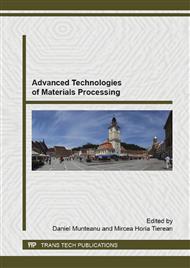[1]
A.W. L Yao, Applications of 3D scanning and reverse engineering techniques for quality control of quick response products, Int. J. Adv. Manuf. Technol. 2005, 26, 1284-1288.
DOI: 10.1007/s00170-004-2116-5
Google Scholar
[2]
C.M. Cheah, C.K. Chua, C.W. Lee, C. Feng, K. Totong, Rapid prototyping and tooling techniques: a review of applications for rapid investment casting, Int J Adv Manuf Technol 2005, 25, 308–320.
DOI: 10.1007/s00170-003-1840-6
Google Scholar
[3]
F. Prieto, R. Lepage, P. Boulanger, T. Redarce, A CAD-based 3D data acquisition strategy for inspection, Machine Vision and Applications 2003, 15, 76-91.
DOI: 10.1007/s00138-003-0131-4
Google Scholar
[4]
E. Vezzetti, Computer aided inspection: design of customer-oriented benchmark for noncontact 3D scanner evaluation, Int. J. Manuf. Technol. 2009, 41, 1140-1151.
DOI: 10.1007/s00170-008-1562-x
Google Scholar
[5]
S. Malassiotis, M.G. Strintzis, Stereo vision system for precision dimensional inspection of 3D holes, Machine Vision and Applications 2003, 15, 101 – 113.
DOI: 10.1007/s00138-003-0132-3
Google Scholar
[6]
J. Makem, H. Ou, C.G. Armstrong, A. Rennie, S. Nikov, A Virtual Inspection Technique for Asssesing the Dimensional Accuracy of Forged Compressor Blades Using FE Modeling and CMM Inspection, Int. J. Mater. Form. 2008, Suppl., 1, 375 – 378.
DOI: 10.1007/s12289-008-0073-5
Google Scholar
[7]
Artec Studio 9 – User Guide, Sept. (2012).
Google Scholar
[8]
M. J. Milroy, D. J. Weir, C. Bradley, G. W. Vickers, Reverse Engineering Employing a 3D Laser Scanner: A Case Study, Int J Adv Manuf Technol 1996, 12, 111-121.
DOI: 10.1007/bf01178951
Google Scholar
[9]
W. L. Cheng, C. H. Menq, Integrated laser/CMM system for the dimensional Inspection of objects made on soft material, International Journal of Advanced Manufacturing Technology, 1995, 10, 36–45.
DOI: 10.1007/bf01184276
Google Scholar
[10]
A. Küng, F. Meli, Self calibration method for 3D roundness of spheres using an ultraprecision coordinate measuring machine, Proc. of 5th Euspen International Conference - Montpellier – France, May 2005, 1, p.193.
Google Scholar
[11]
Information on http: /www. weld. labs. gov. cn.
Google Scholar
[11]
V. Carbone, M. Carocci, E. Savio, G. Sansoni, L. De Chiffre, Combination of a Vision System and a Coordinate Measuring Machine for the Reverse Engineering of Freeform Surfaces, Int J Adv Manuf Technol, 2001, 17, 263–271.
DOI: 10.1007/s001700170179
Google Scholar
[12]
D.H. Zhang, R.S. Jiang, J.L. Li, W.H. Wang, K. Bu, Cavity optimization for investment casting die of turbine blade based on reverse engineering, Int J Adv Manuf Technol, 2010, 48, 839–846.
DOI: 10.1007/s00170-009-2343-x
Google Scholar
[13]
G. Matache, C. Puscasu, V. Dragan, R. Alionte, Setup and testing of a 3D scanning method for dimensional inspection of small size cast turbine blade, Metalurgia International, vol. XVIII (2013), no. 6, 295-297.
DOI: 10.4028/www.scientific.net/amr.1128.347
Google Scholar


